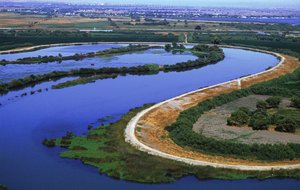You are here
Water Scarcity in California's Bay-Delta Necessitates “Hard Decisions”
Primary tabs
 California's Bay-Delta water supply area // Source: usgs.gov
California's Bay-Delta water supply area // Source: usgs.gov
submitted by Samuel Bendett
Homeland Security News Wire - March 30, 2012
Simultaneously attaining a reliable water supply for California and protecting and rehabilitating its Bay-Delta ecosystem cannot be realized until better planning can identify how trade-offs between these two goals will be managed when water is limited, says a new report from the National Research Council. Recent efforts have been ineffective in meeting these goals because management is distributed among many agencies and organizations, which hinders development and implementation of an integrated, comprehensive plan. Additionally, it is impossible to restore the delta habitat to its pre-disturbance state because of the extensive physical and ecological changes that have already taken place and are still occurring, including those due to multiple environmental stressors.
A national Academy of Sciences release reports that the delta region receives fresh water from the Sacramento and San Joaquin rivers and their tributaries, and ultimately flows into San Francisco Bay and the Pacific Ocean. Water-pumping stations divert water from the delta, primarily to supply Central Valley agriculture and metropolitan areas in southern California, the Bay Area, and the delta itself. An increasing population and the operation of the engineered water-control system have substantially altered the delta ecosystem, including its fish species. Conflicts among various water users have grown, and there are sharp differences of opinion concerning the timing and amount of water that can be diverted from the delta for agricultural, municipal, and industrial purposes and how much water, and of what quality, is needed to protect the delta ecosystem. The U.S. departments of the Interior and Commerce asked the Research Council to identify the factors affecting fish species in the delta, review future water supply and delivery options, determine gaps in knowledge, and advise on the degree of delta restoration that is attainable while maintaining both an environmentally sustainable ecosystem and a reliable water supply.
It is likely that water scarcity in the delta will become increasingly severe, the report says.
Failure to acknowledge this problem and craft plans and policies that address water scarcity for all needs has made delta water management more difficult than is necessary. The committee that wrote the report suggested establishing priorities for water use, accounting for trade-offs in decision making, optimizing the availability of existing water supplies, enforcing California’s constitutional prohibition against non-beneficial and wasteful water use, and practicing water conservation, among other principles and guidelines.
Multiple environmental stressors — such as dams; water pumping stations; introduced and invasive species; and changes in nitrogen and phosphorus concentrations and amounts, water flow, and habitat — negatively affect five delta fishes listed as endangered or threatened, the committee said.
Successfully rehabilitating the delta ecosystem by targeting how an individual stressor impacts a particular species seems doubtful. Therefore, hard decisions will need to be made about balancing risks for different water uses, such as allocating water to support economic activity, sanitation, or other needs. In addition, alleviating any one stressor alone is unlikely to reverse declines in these species, but opportunities exist to mitigate or reverse the effects of many stressors. To increase the likelihood that actions to rehabilitate the ecosystem are cost-effective, continued analyses, modeling, and monitoring will be needed, the committee noted.
The release notes that climate change is one of the most challenging and important issues confronting the management and rehabilitation of the delta ecosystem. It is expected to affect the physical and ecological structure and functioning of the delta as well as the availability of water in the state. For instance, assessments suggest that many species will be affected by changes in runoff from precipitation and snowmelt, which would likely occur earlier in the year than currently. In addition, projected sea-level rise and extremes of precipitation could increase the frequency of levee failure and the inundation of islands. Sea-level rise also has the potential to move more salt water into the delta and alter water quality. The committee recommended that future planning should include a climate change-based risk model, analysis that incorporates data on the actual changes in delta conditions, and alternative future climate scenarios and their probability.
Additionally, the instability of levees and potential of one levee failure to affect others are liable to be major issues for achieving any measure of water supply reliability or ecosystem rehabilitation. Continuing the status quo of improving levees will not always be the most environmentally sustainable or economically defensible response in the years ahead, the committee noted.
The lack of integrated, comprehensive planning has made science less useful in decision making for the delta, the committee said. It recommended that California review water planning and management in anticipation of future circumstances. This review should devote attention to water scarcity, balanced consideration of all statewide water uses and the practices that govern them, and available engineering alternatives. In the absence of a review, it would be difficult to resolve delta water management problems in other than a piecemeal fashion.
“Science is necessary to inform actions and proposals, but it does not provide the entire overview and integration that the committee recommends,” said committee member Henry J. Vaux Jr., professor emeritus of resource economics at the University of California. “Societal and political considerations are also integral factors in determining the most appropriate policies toward managing the water resources in the delta and balancing the needs of all water users.”
The study was sponsored by the U.S. Department of the Interior and U.S. Department of Commerce.
— Read more in “Sustainable Water and Environmental Management in the California Bay-Delta”



Recent Comments